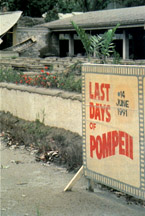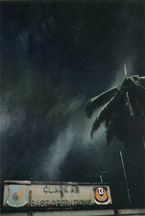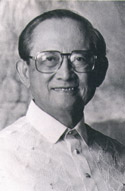
Children of the volcano: Aeta children in Pasbul, Kamias, Porac.

Prescient theater: advertisement for a play overtaken by real events, Clark Air Base.

Dark ash cloud over Clark's Base Operations building, June 22, 1991. Photograph by R.P. Hoblitt.
FIRE and MUD: Eruptions and Lahars of Mount Pinatubo, Philippines
CHRISTOPHER G. NEWHALL, Geologist, U.S. Geological Survey, Affiliate Professor, University of Washington Volcano Systems Center,
AND
RAYMUNDO S. PUNONGBAYAN, Director, Philippine Institute of Volcanology and Seismology
Philippine Institute of Volcanology and Seismology
Quezon City
University of Washington Press
Seattle and London
1996
Printed in Hong Kong
A disk, prepared by the United States Geological Survey, accompanies the book. The disk contains two programs, PINAPLOT (for DOS) and VOLQUAKE (for Windows), both of which show the evolving seismicity before and after the 1991 eruptions of Pinatubo. VOLQUAKE also includes data sets for Mount St. Helens and Mount Spurr.
The book will be available on USGS and PHIVOLCS web sites.
Clear and present danger is a great unifier. When Mount Pinatubo devastated our land in 1991, it dissolved geographical, cultural, and economic barriers. Filipinos were one with each other and with the world as spontaneous aid poured into the Pinatubo region. Colleagues in the international scientific community came to help, not only to address the disaster of the moment, but also to resolve underlying scientific and technological problems of future hazards as well.
The significance of the Pinatubo experience lies not only in the successful forecasting of eruptions and lahar flows. It also highlighted many new challenges. As a circle of light increases, so does the circumference of darkness that surrounds it.

The Pinatubo event indeed shed plenty of light in volcanology. But it also highlighted many new questions: Will there be more devastating eruptions from Pinatubo? What is the volcano's eruption recurrence cycle? How do we deal with the Pinatubo lahars to minimize risk without stalling the region's development? What are the long-term impacts of volcanic deposits on the region's agricultural productivity? Which of our potentially active volcanoes will behave like Pinatubo and erupt after centuries of inactivity?
This monograph is a story of our tension, grief, insight, and relief. It also points to knowledge gaps that we must still bridge. It serves as a monument to scientific internationalism that has proven its worth. And through this monograph, we invite every reader to relive our experience at Pinatubo and to join us in taking up the new challenges ahead.
Fidel V. Ramos
The 1991 eruptions of Mount Pinatubo and subsequent widespread lahars are signal events both in volcanology and volcanic hazards mitigation. Accurate forecasting of the scale and date of an eruption is never easy, especially when the threatening volcano has not been monitored previously. Against considerable odds and with some critical logistical help, a small team of Philippine and U.S. scientists managed to avert a terrible disaster. Neither the eruption nor the lahars could be stopped, but, within the first 5 years of the crisis, hundreds of thousands of people have been warned and moved temporarily to safety.
The goals of this monograph are to capture a vast array of observations about the remarkable events before, during, and since the climactic eruption of Mount Pinatubo, to synthesize those observations into an understanding of Pinatubo as a dynamic, complex volcanic system (within an equally dynamic and complex social setting), and to make both observations and interpretations accessible to volcanologists around the world, especially those who must cope with similar crises in the future.
This last-mentioned goal bears special attention: Eruptions and lahars of Pinatubo's magnitude occur but a few times per century, and even less frequently in populated areas. But every geologist who studies volcanoes can identify scores of volcanoes at which such events are possible--some surrounded by even greater populations than Pinatubo. Because the options for precautionary actions are so limited around densely populated volcanoes, future forecasts must be as precise and accurate as possible. We might have only one chance to be right, for, after that, our credibility will be tenuous at best. This volume will be a vital reference for those who must make similarly difficult, high-stakes forecasts in the future. Even after such a large eruption has occurred, hazards from lahars and massive volumes of sediment will challenge the cleverest engineer, social scientist, and politician. Here, too, this volume will be a valuable reference.
We have not edited the volume specifically for student use, but instructors of volcanology will find within this monograph a selection of papers that illustrate great scholarly and practical value of viewing a volcano as a dynamic system, and, within such a dynamic system, speedy analogs of many otherwise hard-to-observe geologic processes. Advanced students will delight in seeing how their previous study in separate disciplines can be integrated and brought to bear on complex problems.
Another entire group of scientists--atmospheric scientists--also learned much from the disturbance that Pinatubo thrust into the atmosphere. Many exciting papers have resulted. These are beyond the scope of the present volume, but our last paper, by Self and others, bridges between the solid earth and atmospheric sciences and refers readers to literature of the latter.
International collaboration was notable at Mount Pinatubo--first, between Philippine and U.S. scientists, and later, spontaneously, involving scientists from at least 10 countries. An event of this magnitude would challenge any single country, and, because volcanological communities are typically small, it makes good sense for volcanologists to help each other in times of major crisis. Help given in one year is help received in the next. The Pinatubo effort epitomizes the spirit of the International Decade for Natural Disaster Reduction--international learning, from each other in a rare natural laboratory, with the ultimate goal of averting disasters wherever they might threaten.
Some of the papers in this monograph are by veterans of many volcanic crises; others are by younger scientists for whom Pinatubo was either a first eruption or for whom publication here is a first international publication. We take special pleasure in this mix, and thank both the veteran mentors and the younger scientists for their patience with each other and with the editors. Thirty-nine of the authors are or were students, including 11 first authors. Every veteran went back to school at Pinatubo, and many students are well along the way to becoming expert mentors.
Editors must make many choices on which papers and interpretations to accept. With an event like that of Pinatubo, some observations and interpretations simply cannot be confirmed or tested, either because of the extreme logistical or safety considerations or because a feature was ephemeral and is no longer the same or even present. Some data sets in this collection are regrettably sparse, but events cannot be restaged. Accordingly, as a rule of thumb, we have accepted papers that contain useful though sparse data. We have not accepted data or interpretations that are unlikely to be correct, but we have given the benefit of any remaining doubt to the author and have included some assertions that we cannot confirm.
We have worked with authors to reconcile discrepancies in observations and interpretations. Where that could be achieved, the results will be apparent as cross-references to mutually important points. Where it couldn't be achieved, we've allowed differences to stand and have noted them in the introduction to each section.
The schedule for preparation of a collection of this size, with authors around the world, poses special problems. Events like a giant eruption beg for early publication of results. However, there is also an argument for allowing the volcano enough time to show posteruption trends and allowing authors time to collect and analyze rich data sets and to communicate with each other. Some authors finished manuscripts within months; others were still in the field, struggling with ongoing monitoring responsibilities. Communication between authors will be evident in the papers; many, though perhaps not all, geographic and language barriers were overcome. Since asking for initial contributions in January 1993, we have pushed slower or busier authors hard, while begging for patience from those who were faster. Our goal was to balance timeliness with completeness.
Late in the preparation of this monograph, literally after type had been set, a budget crisis for the originally-intended publisher, the U.S. Geological Survey, forced us to choose between CD-ROM publication (only) and publication of this book by an alternate publisher. You can see that we chose the latter, and we will also make an electronic version available on the World-Wide Web. We welcome feedback from readers of both versions.
Chris Newhall, Seattle Children of the volcano: Aeta children in Pasbul, Kamias, Porac. |
|
 Prescient theater: advertisement for a play overtaken by real events, Clark Air Base. |
 Dark ash cloud over Clark's Base Operations building, June 22, 1991. Photograph by R.P. Hoblitt. |
Many people have helped us to prepare this chronicle of Pinatubo. A simple thanks does injustice to their contributions; a more elaborate thanks, detailing each person's and group's contributions, would be a book unto itself. A Tagalog word, bayanihan, meaning an unreservedly cooperative effort to complete a big task, is an apt description for the outpouring of help that we have enjoyed.
Starting first with data collection, processing, and interpretation, we want to thank authors, with whom it has been our great pleasure and privilege to work. Your eyes and minds have captured a remarkable story. We also thank your many assistants--field assistants, lab assistants, secretaries, drafting assistants, and many more--who do not appear as authors but without whom the volume would be painfully thin. One co-author who deserves special thanks is Ma. Theresa Regalado, who served as the first editor's right hand, literally and figuratively, following an unscheduled injury.
Logistical assistance at Pinatubo required a special commitment, not only in hours, but in personal risk and sacrifice. Data sets in this collection, and successful mitigation measures that were based on those data, simply would not have been possible without sterling helicopter and fixed-wing support from the Philippine Air Force, U.S. Air Force, U.S. Navy, U.S. Marines, and the late Agustin Consunji. Drivers from USAID/Philippines, PHIVOLCS, the Philippine Mines and Geosciences Bureau, and the University of the Philippines not only kept us mobile on the ground but also doubled as field assistants, cooks, and other key support.
Critical reviews are essential for credibility. Reviewers are acknowledged in individual papers; we list them here, too, alphabetically, with our heartfelt thanks for a job well done. They were:
David Alexander, Fred Anderson, Onie Arboleda, Rich Bernknopf, Russell Blong, Marcus Bursik, Steve Carey, Mike Carroll, Tom Casadevall, Kathy Cashman, Pat Castillo, Bill Chadwick, Bernard Chouet, Toti Corpuz, John Costa, Doug Crowe, Art Daag, Mark Defant, PJ Delos Reyes, Rick Dinicola, Mike Dolan, Mary Donato, Mike Doukas, Dan Dzurisin, Jerry Eaton, Elliot Endo, John Ewert, Jon Fink, John Fournelle, Bruce Freeman, Elmer Gabinete, Terry Gerlach, Paula Gori, Marianne Guffanti, Dave Harlow, Brian Hausback, Wes Hildreth, Dave Hill, Todd Hinkley, Rick Hoblitt, Rick Holasek, Mark Holmes, Akira Imai, Chip Johnson, Juergen Kienle, Ulrich Knittel, Tak Koyaguchi, Dennis Krohn, Ed Laguerta, John Lahr, Rick LaHusen, Willie Lee, Jonathan Lees, Pete Lipman, Andy Lockhart, Jake Lowenstern, Jim Luhr, Jon Major, Steve Malone, Mylene Martinez, Mike McKibben, Steve McNutt, Bill Melson, Gerry Middleton, Dennis Mileti, C. Dan Miller, Seth Moran, Jim Mori, Vince Neall, Scott Oswalt, Bob Page, John Pallister, Jill Pasteris, Resty Pelayo, Tom Pierson, John Power, Manoling Ramos, Thess Regalado, Mark Reid, Jim Riehle, Alan Robock, Kelvin Rodolfo, Ed Roedder, Bill Rose, Gary Rowe, Mac Rutherford, Julio Sabit, Yoshihiro Sawada, Kevin Scott, Willie Scott, Steve Self, Pat Shanks, Haraldur Sigurdsson, Gary Smith, Kathleen Smith, Stu Smith, Rene Solidum, David Sussman, Don Swanson, Azadeh Tabazadeh, Makoto Tahira, Motoo Ukawa, Jess Umbal, Barry Voight, Richard Waitt, Lou Walter, Craig Weaver, Kelin Whipple, Randy White, Gerry Wieczorek, Stan Williams, and Ed Wolfe.
Papers in this volume reflect work done both for immediate hazard mitigation and for research. For the first purpose, we gratefully acknowledge team funding from Office of President Fidel V. Ramos, the Philippine Department of Science and Technology, U.S. Department of Interior, the Philippine National Disaster Coordinating Council, UNESCO, USAID/OFDA, USAID/ Philippines, and the U.S. Department of Defense. For the second purpose, and for preparation of this volume, we gratefully acknowledge funds from our respective departments and a wide variety of research funding sources, including the U.S. National Science Foundation, that are acknowledged in individual papers. Most USGS funds came from its Volcano Hazards Program; we also thank its Earthquake Hazards Reduction Program, Pacific Northwest region, for valuable support during final preparation of this monograph.
The publishers of this book--PHIVOLCS and the University of Washington Press--together with the originally-intended and now-assisting publisher, the U.S. Geological Survey--are new trailmates in new terrain. Budgetary circumstances forced the USGS to seek immediate help. The USGS' Branch of Eastern Technical Reports agreed to finish camera-ready copy and PHIVOLCS, which had already contributed many papers, arranged a subsidy from the Mount Pinatubo Commission (see special acknowledgments, next page). Naomi Pascal, Pat Soden, and Veronica Seyd of the University of Washington Press responded with much-appreciated trust and flexibility, accepting the book as written and agreeing to a concurrent World-Wide Web version. We look forward to hiking the rest of the trail together, despite the unusual circumstances under which we met!
We close this preface and acknowledgment with grateful thanks to the families of all who have worked at Pinatubo, for being supportive through initial risks and later exhaustion. We also recall, with enormous respect, wise guidance from the late Dick Janda that we use still today as Pinatubo lahars continue.
Chris Newhall and Ray Punongbayan, editors
When a budget crisis in the U.S. Geological Survey forced us to change publishers, three organizations stepped forward with special help.
The USGS' Branch of Eastern Technical Reports (BETR), which had been preparing the monograph for USGS publication, was suddenly faced with the prospect that this report in which it had invested enormous amounts of time and skill might not get published. Two BETR employees in particular, Arlene Compher for illustrations and John Watson for text, had shaped many a gem in the rough into a polished product, with remarkable cheer and patience. Then, despite a painful reorganization and reduction-in-force, Arlene, John, Carolyn McQuaig for typesetting, Dave Murphy for final graphics work, and other BETR employees finished this huge job with great professional dedication.
The USGS also donated copies of its Mount St. Helens Professional Paper 1250, as in-kind publication support and to afford readers a chance to obtain this classic monograph together with the present Pinatubo volume.
The second group to whom we owe special thanks is the Mount Pinatubo Commission, chaired by the Hon. Salvador Enriquez (Antonio A. Fernando, Executive Director). The Mount Pinatubo Commission draws from government agencies and non-governmental organizations to manage relief and recovery from the Pinatubo eruption, including evacuation camps, resettlement areas, sediment control measures, and reconstruction of infrastructure. In recognition of the importance of Pinatubo events in volcanology and of a good understanding of volcanic events before those events can be mitigated, the Commission granted a generous subsidy that assured publication of the book.
The third source of critical support was PHIVOLCS' parent, the Department of Science and Technology (DOST) and its Secretary, Dr. William Padolina. A subsidy from DOST allowed us to print significantly more copies than would otherwise have been possible, and to offer this volume at an affordable price.
Thanks to these three organizations, many may learn the lessons of Pinatubo.
FIRE and MUD Contents | Volcanic Drama, Human Drama
PHIVOLCS | University of Washington Press | U.S.Geological Survey
This page is <https://pubs.usgs.gov/pinatubo/prelim.html>
Contact: Chris Newhall
Last updated 09.17.98